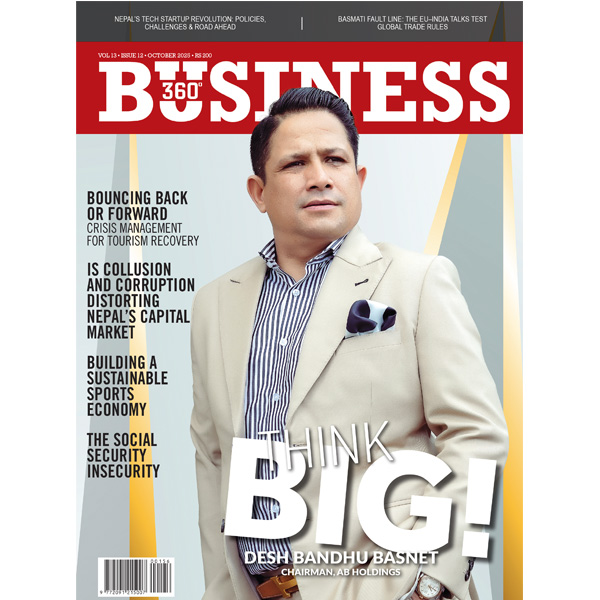
Over the past few years, helicopter services have seen an increased demand in the tourism and medical sectors of Nepal. “As the topography of our country is complex with places that are accessible only by helicopters their use, especially for evacuation purposes, has been growing quite considerably,” says Murali Dhar Joshi, Head of Administration and Finance of Simrik Air. “Moreover, since the government adopted a more liberal aviation strategy in 1992, helicopter services have become one of the most crucial forms of transportation across the country,” he adds.
At present, there are 11 helicopter service providers operating in the country, with a total of 35 helicopters in operation. “The Airbus AS350 model is the most widely used helicopter in Nepal besides Bell, Robinsons and MI17,” shares Joshi. He further states that previously heavy-lift helicopters were common in the country but these days there is demand for small and medium helicopters.
Helicopter companies over the years were witnessing significant growth with many more people availing their services until the Covid 19 pandemic struck in early 2020. “None of us were prepared for this crisis which consequently hit the helicopter industry too,” says Shree Hari Kuikal, Chief of Operations of Kailash Air. He adds that with travel restrictions imposed by the governments of practically all the countries across the world there was no flow of tourists and this severely impacted them.
Kuikal shares that due to the pandemic most helicopter companies have lost about 75% of their business. “Now with things seeming to settle down, we hope we can pick up from where we left off,” he says. He adds that there will be unforeseen challenges in any line of business that one is involved in and all we need to do is take stock of the situation, change and adapt, if one wants to survive. As a result, companies are now focusing more on local travellers rather than just waiting for foreign tourists to arrive. “In the last two years since the outbreak of the coronavirus pandemic most companies have started focusing on providing services related to pilgrimages, medical evacuations and cargo,” says Joshi. To sustain their business, helicopter companies have begun introducing various packages to attract domestic tourists.
“As the topography of our country is complex with places that are accessible only by helicopters their use, especially for evacuation purposes, has been growing quite considerably” Murali Dhar Joshi Head of Administration and Finance, Simrik AirAmong the packages being offered the one related to sightseeing in the Gosaikunda area was the most sought-after last year, shares Kuikal. “Despite facing problems due to the pandemic, there were nearly 12,000 domestic tourists who availed this package last year,” he adds. The other package that is quite popular is the one to Everest Base Camp but this is mostly sought by foreign travellers, he mentions. “The pandemic has affected us considerably but we expect things to get better now as the government has also relaxed certain provisions for foreigners to visit the country,” says Joshi. “It is during such times that concerned authorities should study the situation properly and introduce policies that can boost local businesses,” he elaborates adding that it is not only about helping helicopter companies but also businesses related to other aspects of tourism like hotels and trekking. “We have to realise that the tourism industry is very interconnected and interdependent so for the entire industry to flourish all the linkages must be up and running,” he emphasises. Both Simrik Air and Kailash Air fly to destinations across the country and their main services are usually related to rescue operations and sight-seeing. “However, one needs to note that sight-seeing services are offered in correspondence to the season and also the weather conditions of the respective destinations,” he shares. Both Kuikal and Joshi share that the high-selling packages are related to the Everest, Manaslu and Annapurna regions. They also mention that another high-selling package is the one to Shey Phoksundo. The other packages that also have quite a number of customers are for Muktinath, Kailash and Dhaulagiri regions. The tourism industry in Nepal has been a growing sector since the first foreigners arrived in the country and it has become the mainstay of the national economy. Its contribution to the national gross domestic product stood at 6.7% in 2019. Moreover, it was also responsible for contributing 6.9% of the total employment in the country. The figures clearly indictate the importance of the tourism industry in the country but it does have its fair share of problems. Besides the recent crisis brought about by the pandemic the other areas that most tourism business have faced over the years are regarding operations and regulatory issues, says Joshi, adding that the helicopter sector has been facing a major problem of lack of skilled human resources.
“In business we have to learn to adapt to the changing situation and introduce changes if you want to survive.” Shree Hari Kuikal Chief of Operations, Kailash AirKuikal adds that another challenge they constantly face is related to air congestion at Tribhuvan International Airport, which is the main and probably the only hub for helicopter service providers in Nepal. “Air traffic congestion is something that is beyond our control or management and is solely connected to the government,” he shares, adding that it is time that the government develop another international airport at the earliest. “It is not only helicopter services being affected but fixed-wing operators too have had to deal with this problem.” “Interestingly, though helicopter services at times could be the only viable means of transportation, local authorities at times make it difficult to access their respective areas”, says Kuikal. “Leaving aside the use of helicopters for tourism purposes there are many times when we need to reach a certain destination for some emergency evacuation but the time that we have to wait to receive permission from the government is very lengthy,” he states. Both Joshi and Kuikal mention that the coordination between local level governments and the central authorities is very weak causing unwanted delays when there are situations where time is the most determining factor like in medical emergencies. They both say that this particular coordination is of utmost necessity because there are places in Nepal where helicopter is the only means during medical emergencies or rescue operations. “It is not that the government has not been addressing the obstacles that helicopter companies have been facing but some regulatory approvals are very cumbersome. The procedures especially needed for flight permission should be streamlined,” says Joshi. According to Kuikel, helicopter companies offer their services on the request of travel agencies and at times insurance companies. “We do not fly to any place without confirming and getting all the relevant information about the clients and also after we have received permission for the flight from the concerned government authority,” he stresses. There are rules to be followed which we duly do and it is not only us but others too which have been following the best business practices, he adds. “But the lengthy flight approval process increases our cost of doing business.” Another area that helicopter companies have to face problems in Nepal are related to insurance, shares Joshi. He explains that insurance companies across the world have been selling insurance schemes and settling claims for travel and expeditions to Nepal but their legal methods regarding claim validations and settlements do not fall under the legal jurisdiction of our country. This, he says makes it difficult for proper and formal validation of claims for insurance companies abroad and for settlements for rescuers or operators. Joshi adds that we need to understand that foreign travellers could also face certain risks when they are in Nepal. “So, it would be a lot easier for everybody concerned if insurance laws here could address the problems of claim validations and operator/rescuer settlements. “Despite the woes, the helicopter industry is still a burgeoning sector in Nepal and if we are able to introduce compatible policies and regulations then the sky is the only limit for helicopter companies here,” concludes Kuikal.
Published Date: October 20, 2021, 12:00 am
Post Comment
E-Magazine
RELATED Feature



-1761806697.jpg)
-1758006240.jpg)
-1752225714.jpg)